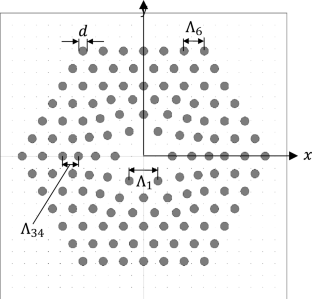Design of graded-index-type photonic crystal fiber with uniform air hole diameter and its application to collimator for single-mode photonic crystal fiber
Abstract
A graded-index (GI)-type photonic crystal fiber (PCF) that has an α-power effective refractive index profile operates as a multimode optical fiber and can be applied to a collimator for single-mode PCFs. The α-power effective index distribution is realized by an α-power air hole diameter distribution with uniform air hole pitch. However, a pressure controlling in fiber drawing is difficult due to the difference of air hole diameters in fiber cross section. In this paper, we propose a GI-PCF with uniform air hole diameter while the air hole pitch varies in radial direction. Light propagation characteristics in the Gaussian beam excited GI-PCF with uniform air hole diameter were theoretically studied. The period and amplitude of mode field diameter variation along the propagation direction for the innermost air hole pitch, air hole diameter, and radial distribution profile of the pitch were clarified. The collimator application of GI-PCF with uniform air hole diameter for a conventional single-mode PCF was investigated. The suitable GI-PCF structure to obtain high optical coupling efficiency and good tolerance for GI-PCF length error was clarified. Wavelength characteristics of the GI-PCF collimator were also studied. It was clarified that the appropriate GI-PCF length was longer for shorter operating wavelength in collimator application.



 求助内容:
求助内容: 应助结果提醒方式:
应助结果提醒方式:


